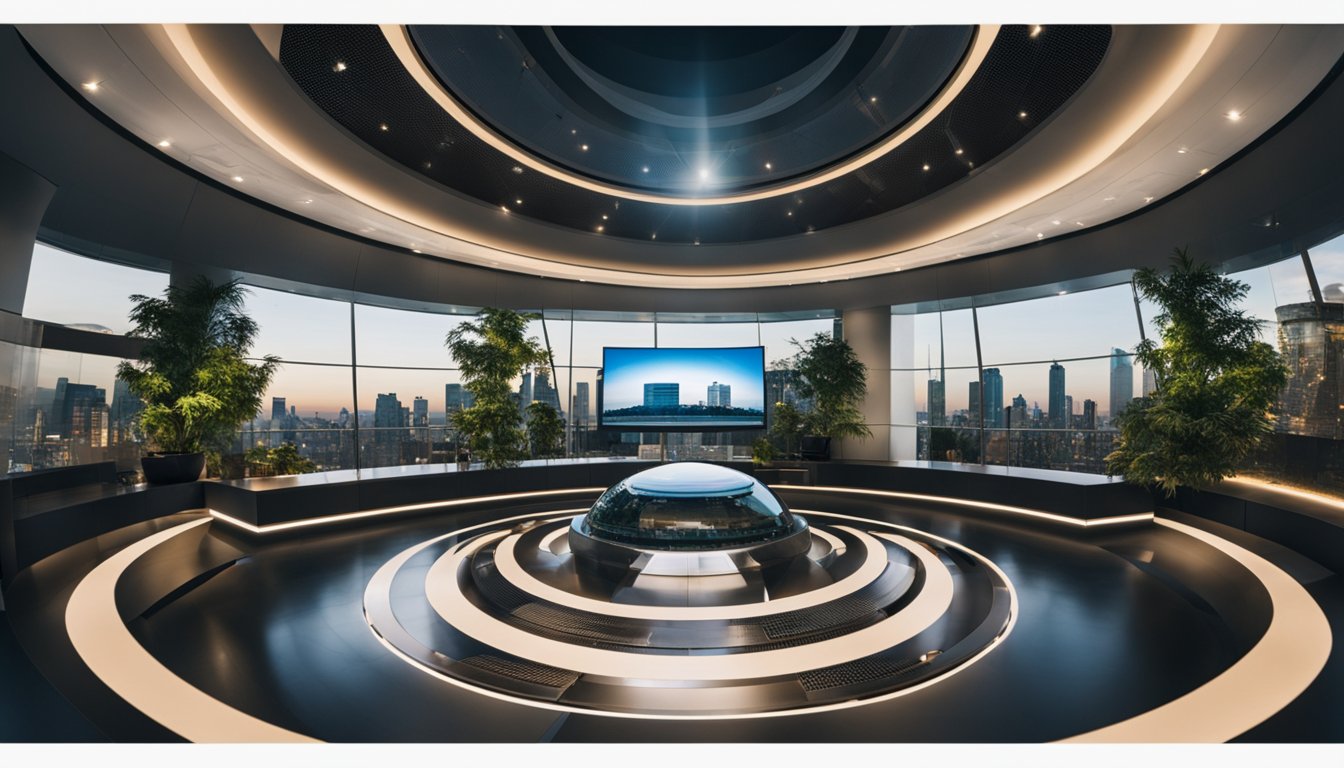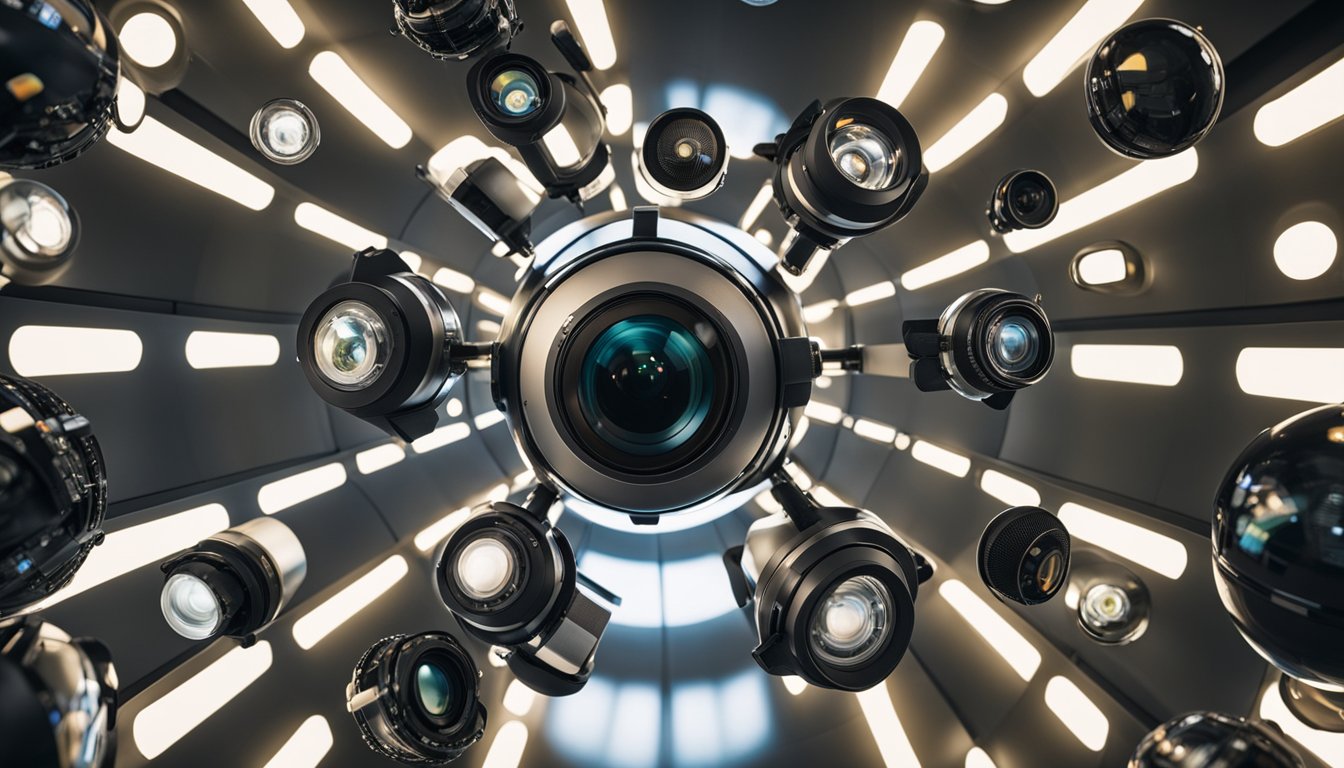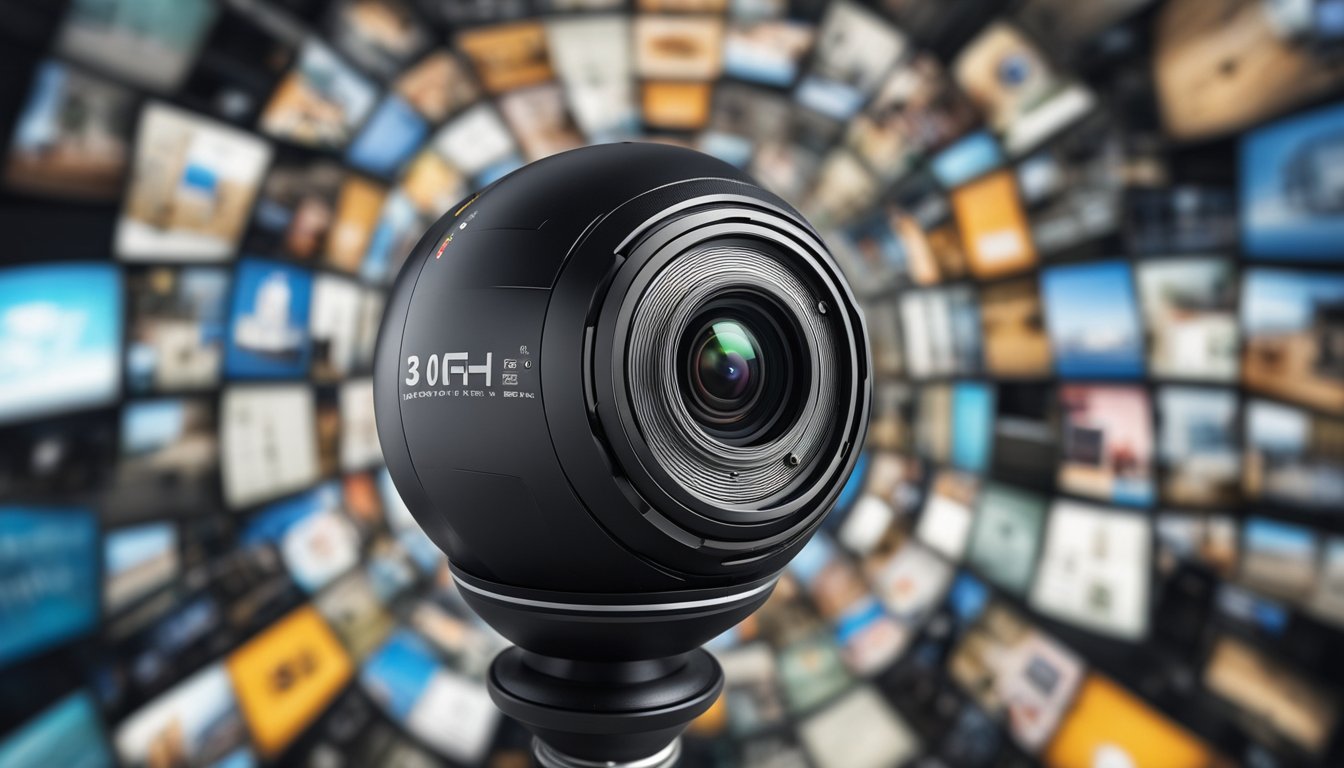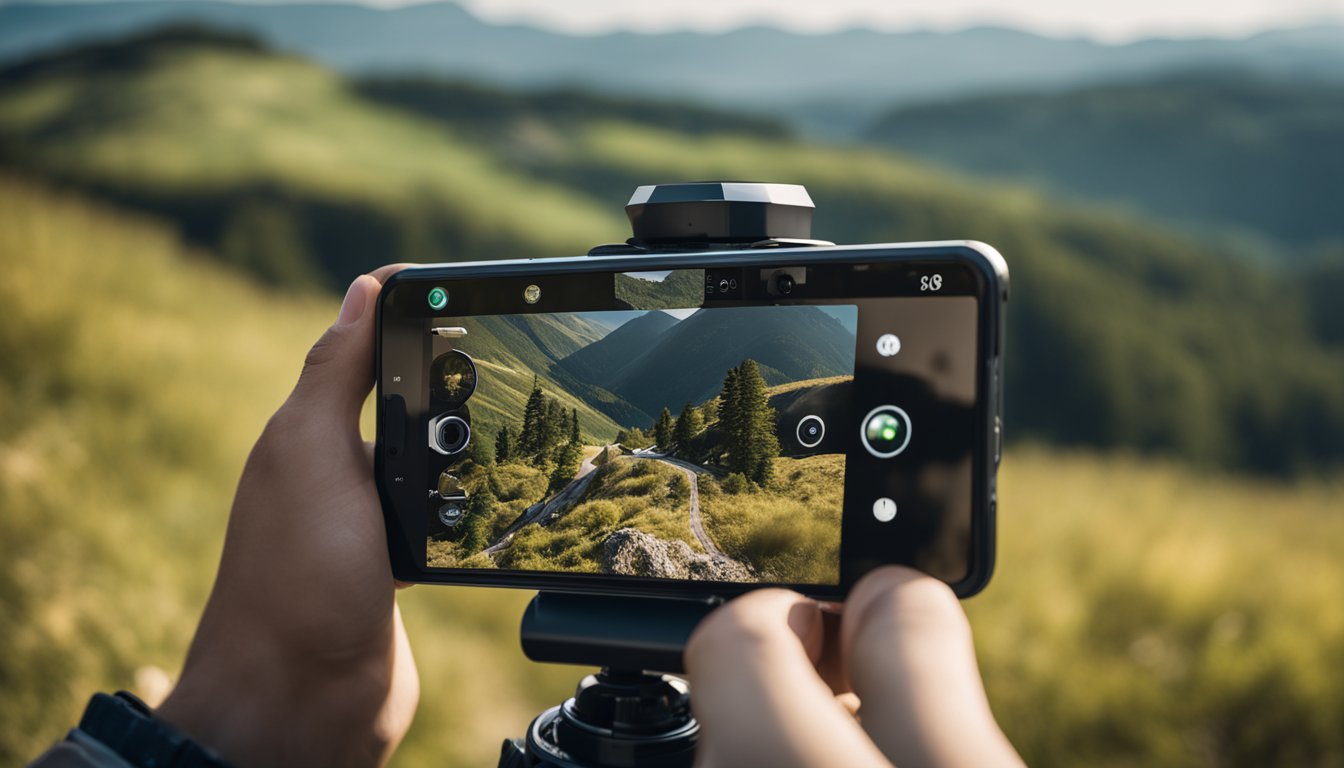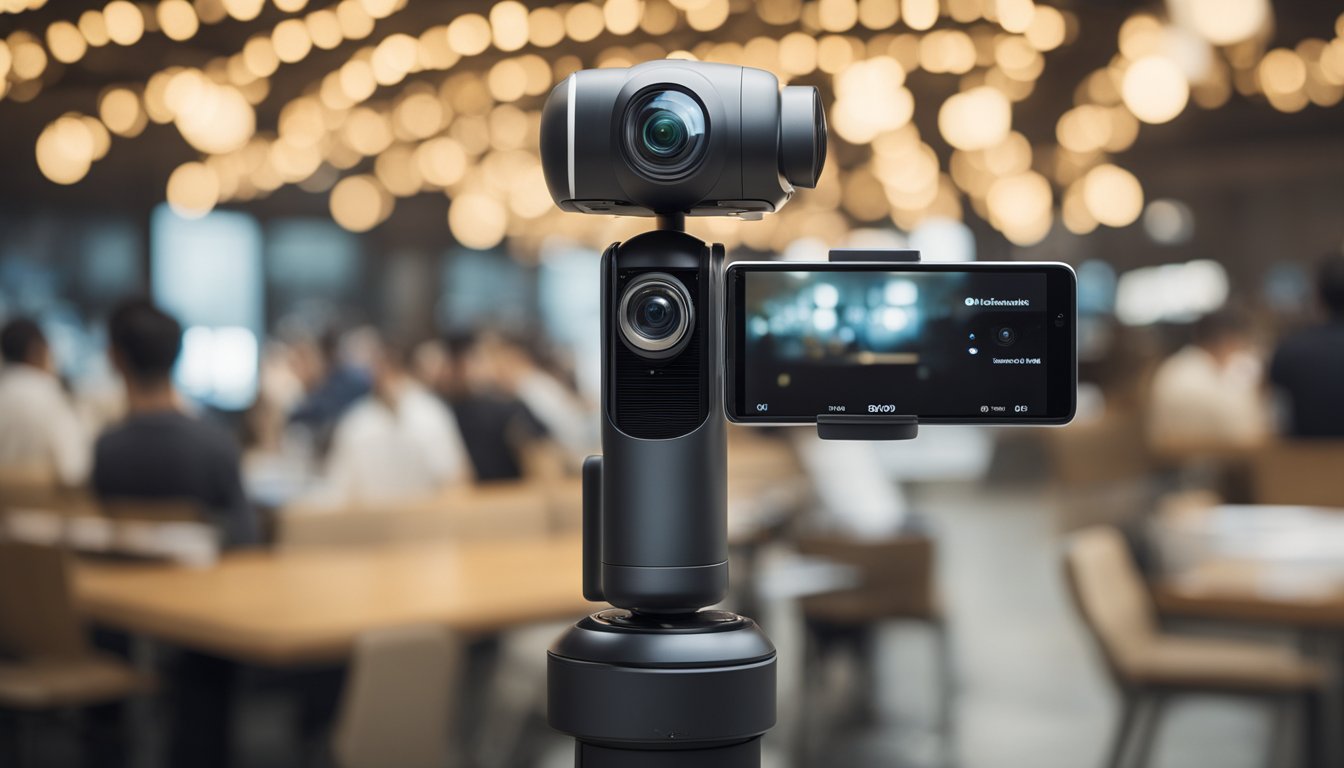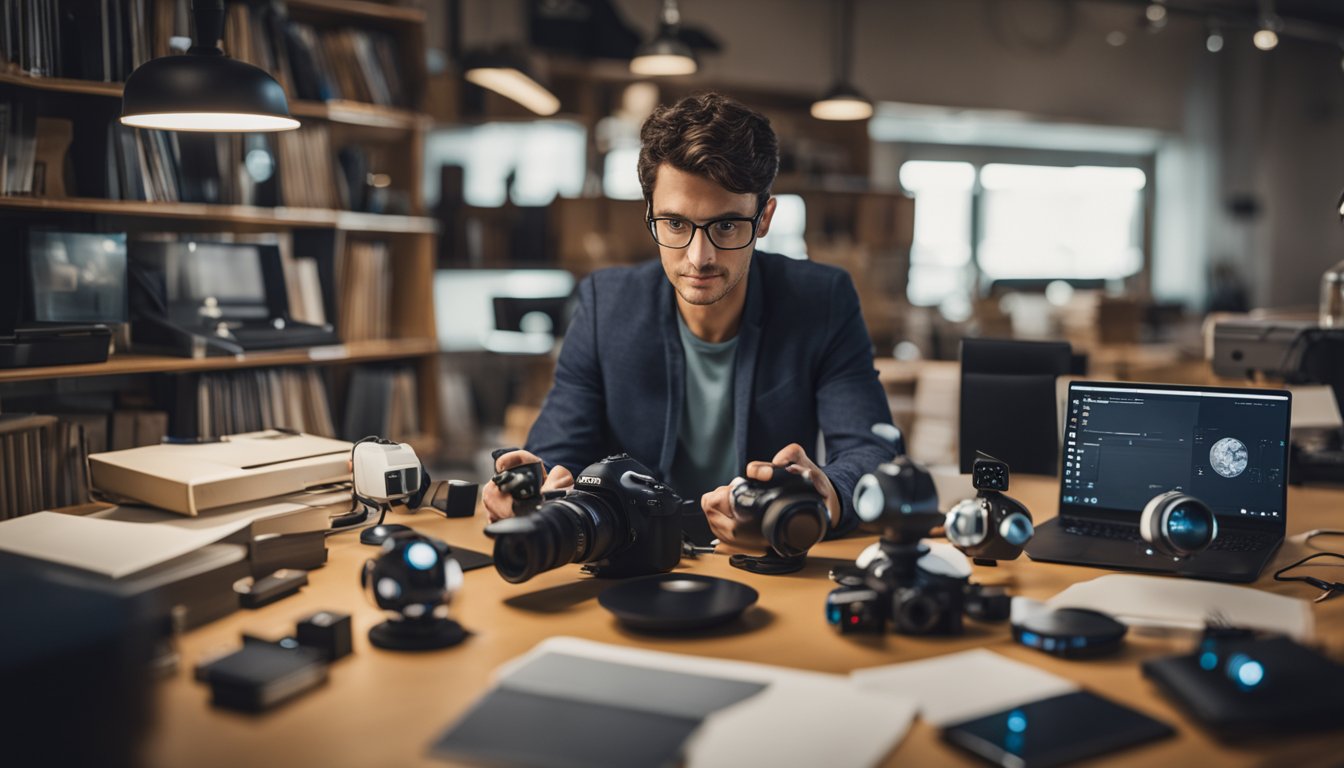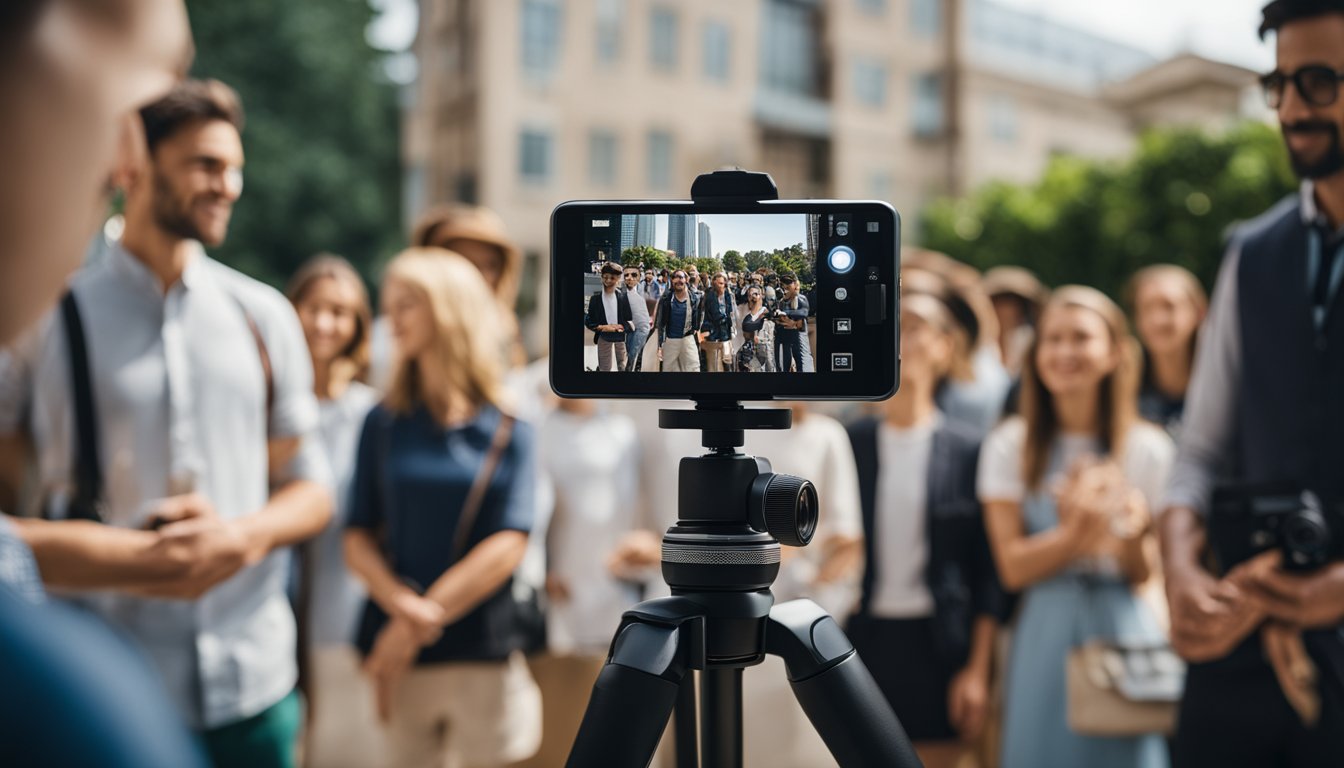When was the 360 camera invented? This is a question that has been on the minds of many photography enthusiasts and professionals alike. The invention of the 360-degree camera has revolutionized the way we capture and view images. With the ability to capture a full 360-degree view of an environment, the 360 camera has opened up new possibilities for virtual reality, immersive experiences, and more.
The origins of the 360 camera can be traced back to the early days of photography. The first panoramic camera was invented in 1857, which captured a full 360-degree view by using fan-governed clockwork mechanics. However, it wasn’t until the advent of digital technology that the 360 camera truly began to take shape. With the rise of digital photography and the development of computer vision algorithms, the 360 camera has become a powerful tool for capturing and sharing immersive experiences.
Key Takeaways:

- The 360 camera has revolutionized the way we capture and view images, opening up new possibilities for virtual reality, immersive experiences, and more.
- The origins of the 360 camera can be traced back to the early days of photography, with the first panoramic camera being invented in 1857.
- With the rise of digital technology and computer vision algorithms, the 360 camera has become a powerful tool for capturing and sharing immersive experiences.
Origins of the 360 Camera
If you’re interested in photography, then you might have heard about 360 cameras. These cameras capture a 360-degree view of the surroundings, allowing you to experience the moment in its entirety. But have you ever wondered when the first 360 camera was invented? In this section, we’ll explore the origins of the 360 camera and its evolution over time.
Early Concepts and Inventors
The concept of capturing a panoramic view of the surroundings dates back to ancient times. The first known mention of the camera obscura, a device that projected an image of the surroundings onto a surface, was by the Arab scholar Ibn al-Haytham in the 11th century. Later, in the 16th century, Leonardo da Vinci and Johannes Kepler both wrote about the camera obscura and its ability to capture panoramic views.
The first practical panoramic camera was invented by Joseph Puchberger in 1843. Puchberger’s camera used a swing-lens design to capture a 150-degree view of the surroundings. This camera paved the way for the development of panoramic cameras in the future.
Development of Panoramic Cameras
The development of panoramic cameras continued throughout the 19th and 20th centuries. In 1851, Alphonse Giroux invented the first true panoramic camera, which used a curved film plane to capture a 120-degree view of the surroundings. This camera was used primarily for landscape photography.
« When Was 360 Degree Camera Launched: A Brief History of 360 Degree Cameras
When Were 360 Cameras Invented? A Brief History of 360-Degree Cameras »
In the early 20th century, panoramic cameras were used for scientific purposes, such as meteorology and astronomy. In 1906, Robert W. Wood invented the fisheye lens, which allowed for a wider range of vision than previous lenses. This lens was later used in the Hill Sky Lens, which was primarily used for atmospheric observation.
The first mass-produced 360-degree panoramic camera was the Al-Vista in America in 1898. This camera used a rotating lens to capture a full 360-degree view of the surroundings. However, it was not until the 1990s that digital panoramic cameras became widely available.
In conclusion, the 360 camera has a rich history that dates back to ancient times. From the camera obscura to the swing-lens camera, the panoramic camera has evolved over time to allow us to capture and experience the moment in its entirety.
Evolution of Photographic Technology
https://www.youtube.com/watch?v=kX6Klp35f4s&embed=true
Photography has come a long way since its inception in the early 19th century. From the first camera obscura to the modern-day digital cameras, photographic technology has undergone significant changes. In this section, we will take a brief look at the evolution of photographic technology.
From Film to Digital
For many years, film cameras were the primary means of capturing photographs. Film cameras used light-sensitive film to capture images, which were then developed in a darkroom. The first digital camera was invented in 1975, but it was not until the 1990s that digital cameras became widely available. Digital cameras use an electronic sensor to capture images, which are then stored on a memory card. The rise of digital photography has made it easier and more affordable for people to capture and store images. Today, most cameras are digital, and film cameras are becoming increasingly rare.
Rise of Camera Phones
The advent of camera phones has revolutionized photography. The first camera phone was introduced in 2000, and since then, camera phones have become ubiquitous. Today, most people carry a camera phone with them at all times, making it easy to capture and share images. Camera phones have also become increasingly sophisticated, with many models featuring high-quality lenses, image stabilization, and other advanced features. The rise of camera phones has also led to the decline of the traditional point-and-shoot camera market.
Overall, the evolution of photographic technology has made it easier and more affordable for people to capture and share images. From film to digital to camera phones, each new technology has brought new possibilities and new challenges. As photographic technology continues to evolve, we can expect to see even more exciting developments in the years to come.
The Invention of the 360-Degree Camera
If you’re a fan of panoramic photography, you might have wondered about the origins of the 360-degree camera. In this section, we’ll take a brief look at the history of this remarkable piece of technology.
First Omnidirectional Cameras
The first omnidirectional cameras that could capture a full 360-degree view were invented in the mid-19th century. In 1857, a camera was patented that rotated around its own axis, using fan-governed clockwork mechanics to capture a full 360-degree view. This was a significant breakthrough in photography, as it allowed photographers to capture a complete view of their surroundings.
Commercialization and Patents
Fast forward to the 21st century, and the 360-degree camera has become a popular tool for capturing immersive video and photography. The commercialization of the 360-degree camera can be traced back to the early 2000s, when companies like Immersive Media and Yellowbird began offering 360-degree video services.
One of the most important patents related to the 360-degree camera was filed by Steve Chen, Chad Hurley, and Jawed Karim, the co-founders of YouTube. In 2014, they filed a patent for a “360-degree camera system for capturing and streaming video.” The patent describes a camera that can capture a 360-degree view and stream it live over the internet.
Other companies have also filed patents related to the 360-degree camera, including Samsung, Sony, and Google. Samsung’s patent describes a camera that can capture a 360-degree view using multiple lenses, while Sony’s patent describes a camera that can capture a 360-degree view using a single lens.
In conclusion, the 360-degree camera has come a long way since its invention in the mid-19th century. Today, it is a popular tool for capturing immersive video and photography, and companies continue to innovate and improve upon the technology.
Modern 360 Cameras and Brands
Insta360 and Ricoh Theta
In recent years, brands like Insta360 and Ricoh Theta have become household names in the 360 camera market. Insta360 One and Ricoh Theta V are two of the most popular 360 cameras on the market, offering high-quality 360-degree photos and videos. The Insta360 One R and Ricoh Theta Z1 are newer models that provide even better features, such as higher resolution and better image stabilization.
The Insta360 One R is a modular camera that allows you to swap out different camera modules, including a 360-degree camera module. The Ricoh Theta Z1, on the other hand, is a high-end 360 camera that offers 23-megapixel resolution, RAW image capture, and 4K video. Both of these cameras are great options for professional photographers and videographers who need high-quality 360 content.
Emergence of Consumer Models
As the 360 camera market has grown, so has the number of consumer-level models. GoPro Max and Insta360 One X2 are two popular models that are more affordable and easier to use than their professional counterparts. These cameras offer features like 360-degree video, image stabilization, and high resolution at a lower price point.
The emergence of consumer-level 360 cameras has made it easier for anyone to capture and share 360-degree content. With the rise of virtual reality and augmented reality, 360 cameras are becoming more important than ever. As a result, the 360 camera market is expected to continue growing in the coming years, with more brands and models entering the market.
Overall, the 360 camera market has come a long way since its inception. With brands like Insta360 and Ricoh Theta leading the charge, and newer models like the Insta360 One R and Ricoh Theta Z1 pushing the boundaries of what is possible, the future of 360 cameras looks bright. Whether you are a professional photographer or a casual user, there is a 360 camera out there that is perfect for you.
Technical Aspects of 360 Cameras
When it comes to 360 cameras, there are a few technical aspects that are important to consider. In this section, we will explore some of the key features and technologies that make 360 cameras possible.
Lens and Stitching Technology
One of the most important aspects of a 360 camera is its lens. Most 360 cameras use two fisheye lenses to capture a full 360-degree image. These lenses are designed to capture as much of the surrounding environment as possible. The images captured by these lenses are then stitched together using software to create a seamless, equirectangular projection.
Stitching technology is a critical component of 360 cameras. This process involves taking the images captured by the fisheye lenses and combining them into a single, seamless image. This can be done using software built into the camera or through post-processing software on a computer. The quality of the stitching can have a significant impact on the final image quality, so it’s important to choose a camera with good stitching capabilities.
Storage and Connectivity
360 cameras capture a lot of data, which means they require a significant amount of storage. Most cameras come with internal storage, but many also have the option to expand storage using an external memory card. It’s important to choose a camera with enough storage to meet your needs.
Connectivity is also an important consideration when choosing a 360 camera. Most cameras connect to a smartphone or tablet using either Bluetooth or Wi-Fi. This allows you to control the camera, view images and videos, and share your content with others. It’s important to choose a camera with connectivity options that are compatible with your device.
Overall, 360 cameras are an exciting technology that allow you to capture immersive, panoramic images and videos. By considering the lens and stitching technology, storage, and connectivity options, you can choose a camera that meets your needs and allows you to capture stunning 360-degree content.
Usage and Applications
360-degree cameras have become increasingly popular in recent years due to their ability to capture immersive and interactive content. They have a wide range of applications, from virtual tours to social media and entertainment. In this section, we will explore some of the most popular uses of 360-degree cameras.
Virtual Tours and Real Estate
One of the most common applications of 360-degree cameras is in virtual tours. They allow you to create immersive experiences that make viewers feel like they are actually in the space. This is particularly useful in real estate, where potential buyers can take virtual tours of properties before deciding to visit in person. According to call360.live, the first mass-produced 360-degree panoramic camera was the Al-Vista in America in 1898.
360-degree cameras can also be used to create virtual tours of hotels, museums, and other attractions. This allows people to explore these spaces from the comfort of their own homes. It’s a great way to showcase what your business has to offer and attract new customers.
Social Media and Entertainment
360-degree cameras have also become popular on social media platforms like Facebook, Instagram, and YouTube. They allow users to create immersive videos and photos that can be shared with friends and followers. This is particularly useful in the entertainment industry, where 360-degree cameras are used to create immersive music videos and live performances.
According to digitalcameraworld.com, 360 cameras are also great for creating panoramic photos. These photos capture an entire scene in a single shot, making them perfect for landscapes and cityscapes.
In addition to social media and entertainment, 360-degree cameras are also used to create immersive videos for training and education. They allow learners to experience simulations and scenarios in a realistic way, making it easier to understand complex concepts.
Overall, 360-degree cameras have a wide range of applications and are becoming increasingly popular due to their ability to capture immersive and interactive content. Whether you’re in real estate, entertainment, or education, a 360-degree camera can help you create engaging content that captivates your audience.
Integration with Other Technologies
360-degree cameras have become increasingly popular in recent years due to their integration with other technologies. The ability to capture an immersive view of the world has made 360 cameras a valuable tool in various industries.
Virtual Reality (VR)
One of the most significant integrations of 360 cameras is with virtual reality (VR) technology. VR headsets such as Google Cardboard and Oculus Rift allow users to experience a fully immersive environment. 360 cameras capture a complete view of the surroundings, which can then be used to create a VR experience. This integration has proved to be valuable in industries such as real estate, travel, and education.
Mobile and Desktop Devices
360 cameras have also become increasingly popular for use with mobile and desktop devices. Many smartphones and tablets now have built-in 360 camera capabilities, allowing users to capture 360-degree photos and videos. Desktop and laptop computers can also be used with 360 cameras to create immersive experiences.
In addition to the built-in capabilities of mobile and desktop devices, there are also many third-party apps and software available that allow for editing and sharing of 360 content. These tools have made it easier than ever for users to create and share immersive experiences.
Overall, the integration of 360 cameras with other technologies has made them a valuable tool in various industries. From VR experiences to mobile and desktop devices, 360 cameras provide a unique perspective that allows users to capture and share immersive content.
Consumer Considerations
If you’re considering purchasing a 360 camera, there are a few things to keep in mind to make sure you’re making the right choice. In this section, we’ll go over some of the most important factors to consider before making your purchase.
Price and Affordability
One of the most important factors to consider when purchasing a 360 camera is the price. Prices can range from a few hundred dollars to several thousand dollars, so it’s important to determine what your budget is before making your purchase.
It’s also important to keep in mind that the most expensive camera may not always be the best option for you. Consider your needs and what features are important to you, and then look for a camera that fits within your budget.
Choosing the Right 360 Camera
When choosing a 360 camera, there are a few things to keep in mind. First, consider what you’ll be using the camera for. If you’re using it for personal use, you may not need all the features that a professional-grade camera offers.
Another important consideration is compatibility with your mobile device. Some cameras require a specific app to view and edit footage, so make sure the camera you choose is compatible with your device.
Lastly, consider the viewer experience. Some cameras may produce higher quality footage, but if the viewer experience is poor, it may not be worth the investment. Look for a camera that produces high-quality footage and provides a seamless viewer experience.
Overall, when purchasing a 360 camera, it’s important to consider your budget, your needs, and the viewer experience. By keeping these factors in mind, you’ll be able to choose a camera that is right for you.
Impact on Photography and Media
https://www.youtube.com/watch?v=UfYj2PWmxMI&embed=true
The invention of the 360 camera has revolutionized the way we capture and consume visual media. With its ability to capture a full 360-degree view of a subject or property, 360 photography has opened up new possibilities for photographers and cinematographers alike.
360 Photography and Cinematography
360 photography has become increasingly popular in recent years, with many photographers and filmmakers using it to create immersive experiences for their audiences. By capturing a full 360-degree view of a subject, photographers and filmmakers can transport their viewers to a different place and time, allowing them to experience a scene in a way that was previously impossible.
In addition to its use in traditional photography and cinematography, 360 cameras are also being used to capture virtual tours of properties. This has become especially important in the real estate industry, where buyers are often unable to physically visit a property before making a purchase.
Immersive Media and Storytelling
The rise of immersive media has also been greatly impacted by the invention of the 360 camera. With its ability to capture a full 360-degree view of a subject, the 360 camera has become an essential tool for creating immersive experiences for viewers.
By using 360 cameras to capture immersive media, storytellers are able to transport their viewers to a different place and time, allowing them to experience a story in a way that was previously impossible. This has opened up new possibilities for journalists and article writers, who can now use 360 cameras to capture immersive media that allows their readers to experience a story in a more engaging way.
Overall, the invention of the 360 camera has had a significant impact on the world of photography and media. Its ability to capture a full 360-degree view of a subject has opened up new possibilities for photographers, cinematographers, and storytellers alike, allowing them to create immersive experiences for their audiences that were previously impossible.
Future of 360 Cameras
https://www.youtube.com/watch?v=i8EUerX90-0&embed=true
Are you interested in the future of 360 cameras? As technology continues to advance, there are many exciting innovations on the horizon for 360 cameras. In this section, we will explore some of the most exciting developments in the world of 360 cameras.
Innovations on the Horizon
One of the most exciting developments in 360 cameras is the increasing ability to capture 3D images and videos. This technology is still in its infancy, but it has the potential to revolutionize the way we capture and experience visual media. Some companies are already experimenting with 3D 360 cameras, and we can expect to see more of these cameras in the future.
Another exciting development is the increasing use of artificial intelligence (AI) in 360 cameras. This technology can help to improve the quality of images and videos, as well as make it easier to edit and share them. For example, some 360 cameras can use AI to automatically remove unwanted objects from images, or to stitch together multiple images into a seamless panorama.
The Expanding 360 Camera Market
The market for 360 cameras is also expanding rapidly. As more people become interested in capturing and sharing immersive media, the demand for 360 cameras is growing. This has led to an increase in the number of companies producing 360 cameras, as well as a wider range of features and price points.
One of the most popular 360 cameras on the market today is the Insta360 One R. This camera offers a range of features, including the ability to shoot 360-degree video, 4K video, and slow-motion video. It also has a modular design, which allows you to easily swap out different lenses and accessories.
Another type of camera that is becoming more popular is omnidirectional cameras. These cameras offer a wider field of view than traditional 360 cameras, which can be useful for certain applications. For example, omnidirectional cameras are often used in virtual reality (VR) applications, where a wider field of view can help to create a more immersive experience.
As you can see, there are many exciting developments in the world of 360 cameras. Whether you’re a professional photographer or just someone who loves to capture and share visual media, there’s never been a better time to explore the world of 360 cameras.
Frequently Asked Questions
What was the first 360 camera available on the market?
The first mass-produced 360-degree panoramic camera was the Al-Vista in America in 1898, according to Visuon Impact. However, modern 360 cameras that are capable of capturing and stitching together high-resolution images and videos are a relatively recent invention.
How has 360 camera technology evolved since its inception?
360 camera technology has come a long way since the Al-Vista camera. Today’s 360 cameras are much more compact, lightweight, and user-friendly. Some of the latest 360 cameras are capable of capturing 8K video, while others can capture 360-degree spatial audio. Additionally, many 360 cameras now feature built-in stabilization, which helps to reduce camera shake and produce smoother video footage.
Which car model was the pioneer in integrating a 360 camera?
The Infiniti EX35 was the first car model to integrate a 360-degree camera system, according to Car and Driver. The system, which was introduced in 2007, used four cameras mounted on the front, rear, and sides of the car to provide a bird’s-eye view of the vehicle and its surroundings.
When was the first 360-degree video recorded and shared?
The first 360-degree video was recorded and shared in 2015 by a company called Jaunt, according to Digital Camera World. The video, which was shot using a custom-made 360-degree camera rig, was a short film called “Kaiju Fury!” that was designed to showcase the potential of virtual reality storytelling.
What are some popular models of 360 cameras currently available?
Some popular models of 360 cameras currently available include the Insta360 One X2, the GoPro MAX, and the Ricoh Theta Z1, according to call360. These cameras vary in price and features, but they all offer high-quality 360-degree video and photo capabilities.
How do prices vary for different types of 360-degree cameras?
Prices for 360-degree cameras can vary widely depending on the features and capabilities of the camera. Entry-level cameras can be purchased for as little as $100, while high-end professional-grade cameras can cost upwards of $10,000, according to Digital Camera World.

